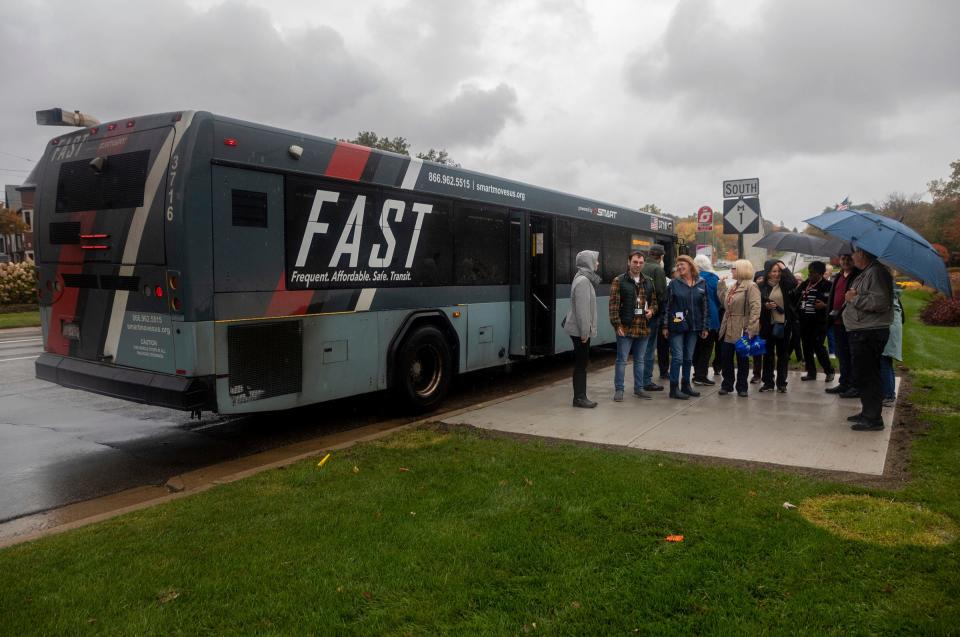Gov. Whitmer, it’s time to think big on public transportation in Michigan | Opinion
On my 16th birthday, my dad took me to the Secretary of State office to get my driver’s license. I’m sure he shared my pride in this moment, because he was my driver’s education teacher at Detroit Henry Ford High School. I started driving to school the following day, and have been driving ever since. This is the paradigm for many Michiganders — well, those of us who stayed.Dozens of friends who grew up right here with me in Southeast Michigan now call Chicago, New York, Los Angeles, Atlanta, Charlotte home (I’m sure I left a few cities out). Recently, my wife and I caught up with two friends from Detroit who now live in New York. I was surprised when one remarked that he hasn’t driven a car in seven years. So much for that car culture engrained in us Michiganders. The reality is that in Michigan, we don’t use public transit en masse because it is inconsistent, unreliable, and mostly, because it is inconvenient.
This past June, Gov. Gretchen Whitmer established the Growing Michigan Together Council to focus on population growth, which has become a major priority. The council, among other aims, “will develop long-term, sustainable transportation and water infrastructure funding solutions.” The council is expected to provide recommendations to the governor on Dec. 1.
Michigan’s population will not grow until we get real about meaningful public transit. Public transportation is consistently cited as a priority for Millennials and Gen Z. Attracting young people is the only path toward population growth here in Michigan.
More from Freep opinion: I've come to think of Grosse Pointe Park as a cautionary tale
Transit is by no means a panacea. But it is a necessary cornerstone to attracting new residents, and keeping our younger residents here.
Population growth depends on bold, visionary leadership that stares inconvenient truths in the face, and puts real solutions forward. It’s time to think big.
Any state looking to grow its population must first make sure its current residents aren’t leaving. By improving the quality of life right here at home — before we recruit transplants and expats — we will be investing in our state’s growth from the inside out.

It’s time to fully connect downtown Detroit; make it easier to navigate between Detroit neighborhoods; and link Detroit to the region — and we need to do this while being smarter about how we pay for it. And yes, our transportation priorities should begin in Michigan’s largest city, Detroit.
The case for transit
For years, the case for expanding transit has been shortsighted, centering on the unemployed gaining access to opportunity and providing workers the ability to get to and from work with dignity. While this is true, and very necessary, all Michiganders benefit from a reliable, convenient, 21st-century transit system. Tiffany Gunter, chief operating officer of SMART (the Suburban Mobility Authority for Regional Transportation), who has spent her career pushing for a more connected region, frames transit this way: “Transit is industry, and it is economic development.”
President John F. Kennedy once asked, “Why go to the moon?” His answer was as simple as it was ambitious: “We choose to go to the Moon in this decade and do other things, not because they are easy, but because they are hard.”
Creating a public transit system worthy of a world-class city is our moonshot, with generational benefits to follow.
Transportation challenges, and solutions
A few months ago, a French woman working as a flight attendant for Air France stopped me on the street in Midtown to ask for directions. This was her second time visiting the U.S, and she had time to explore Detroit before heading home. But she was lost. She wanted to see the Motown Museum. I wanted to help this visitor to my hometown.
It was too difficult to get from Midtown to W. Grand Boulevard and the Lodge Freeway, where the Motown Museum is located, via public transit. It’s about a 50-minute walk, crossing over two freeways, with no intuitive bus route. Because we were in Midtown, I thought it’d be nice for her to see the Spirit of Detroit outside the Coleman A. Young Municipal Center, a straight shot down Woodward Avenue. So we jumped on the QLine. For about 15 minutes, I was a tourist in my own city — through her eyes. Her impressions were revealing. She exclaimed, “Your roads are so big!” and “People seem really spread far apart.” (I also tried to explain Detroit-style pizza. She responded, “Like pizza on a baguette?”)
This exchange really had me thinking about the importance of connecting people, neighborhoods and community assets.
Contributing columnist John Lindstrom: MSU is getting attention for the wrong reasons. Here's how they can fix it.
Our city’s original “hub and spoke” design offers a literal roadmap to update our public transit.
Major freeways envelop and disconnect our 7.2-square mile greater downtown. It is difficult to reach certain areas by walking or cycling, making car transportation the only option. We must fill those gaps. The upcoming I-375 project has the potential to connect downtown to the east side, if done correctly. The new Second Avenue bridge project by the Detroit Region Convention Facility Authority will connect western downtown to the riverfront behind Huntington Place.
But we need to make it easier to connect our downtown’s major destinations. The People Mover feels like it was built for a different era, because it was. But it doesn’t need to stay that way. It's a great connector between the RenCen, Huntington Place and Greektown. Pre-pandemic, the system had more than 2 million riders per year. We should add People Mover stops at MGM Grand Detroit, Comerica Park and Ford Field. Many of its current stations are literally a stone’s throw from one another, or connect to attractions that no longer exist, and should be eliminated.
While much can be said about the time of service, QLINE transformed the Woodward corridor, and has shown major economic development successes. And more people ride the QLine than you think; in 2019, before the pandemic, there were more than a million riders. Expanding the QLine up Michigan Avenue would connect downtown to Corktown, coinciding with the innovative Michigan Avenue redesign. Extending the QLine out Jefferson Avenue would link downtown and another city treasure, Belle Isle.
Neighborhoods need transit, too
Connecting Detroit neighborhoods is equally important. What does real public transit look like? Fast, reliable, multimodal.
Bus Rapid Transit (BRT) would include dedicated bus lanes with traffic light preferences for the major arteries Grand River, Woodward, Gratiot, Jefferson and Seven Mile. It’s outlined in the DDOT Reimagined draft plan. All of these routes currently run (unreliably) every 30 minutes. With Bus Rapid Transit, a bus would run every ten minutes through these corridors, five days per week, and up the frequency on 13 additional routes throughout the city to every fifteen minutes. Of course, this would require more drivers at a much higher wage.
An interconnected city whose residents can get between neighborhoods faster enhances economic development, and will make many more Detroit neighborhoods more desirable places to live.
Transit outside the city
Connecting Detroit to the larger region is the final step for creating a real public transit system. The only rail service in our region today, the Amtrak Wolverine, currently has three trains per day to Chicago leaving from Detroit.
The train stops in Ann Arbor, but not Detroit Metro Airport.
A passenger flying into DTW should be able to get to Downtown Detroit or Downtown Ann Arbor by train in less than an hour, regardless of the traffic on I-94. We can achieve this goal by establishing a fast, reliable rail connection between DTW, Ann Arbor and Detroit. The Amtrack Wolverine should re-establish international service between the Chicago and Toronto corridor with a stop in Detroit (via Windsor).
Public transit doesn't have to be like this
We know what to do. Study after study has recommended improvements and expansions to Detroit regional transit. What we haven’t figured out is how to pay for it. We were close in 2016, when a ballot proposal to fund RTA was narrowly defeated. Perhaps the governor’s population council will propose a new way forward.
No real municipal transit system in this country relies exclusively on property taxes or passenger fares.
We could amend Michigan’s constitution, allowing cities and counties to impose an additional cent of sales tax to fund public transit. One penny per dollar would provide roughly $1 billion in dedicated, sustainable annual revenue.
This would also make our region eligible for billions of dollars in federal grants for light rail projects that we’ve missed out for decades. The U.S. Department of Transportation won’t provide grants to regions like ours that lack sustainable funding models, and relying on piecemeal mileages will never get us there.
An investment approach that puts Michiganders first belies the narrative that we’re spending billions of dollars to attract companies as the pathway to growth.
Convenient transit? There's an idea
Past attempts to coordinate governance among multiple southeast Michigan transit systems have stalled and failed, but there are things we can do to make the system more integrated and seamless. For instance, one should simply be able to go to a single website to navigate to to any destination via public transit (and pay for the ride), as opposed to navigating through multiple providers websites.
We could fund transit by strengthening RTA, set up nearly a decade ago now for that purpose. The governor’s council could explore other ways to strengthen agencies such as DDOT and SMART, and perhaps require systems to cooperate to be eligible for increased funding.
I love driving my car to work every day. But a convenient, reliable, and comprehensive public transit system that better connects downtown, our neighborhoods and this region creates a pathway to growing our state’s population. Our future depends on getting serious about mobility, and that requires us to do what’s hard.

Michael Griffie is an educator and attorney who serves as Detroit Metro Leader for AECOM, an American multinational infrastructure consulting firm. AECOM may bid on transit work in metro Detroit. Submit a letter to the editor at freep.com/letters.
This article originally appeared on Detroit Free Press: Whitmer, want more people in Michigan? Fix transit. Start with Detroit

